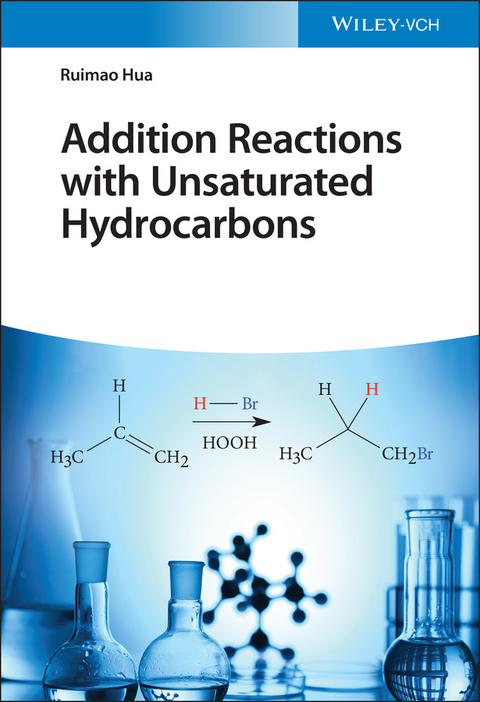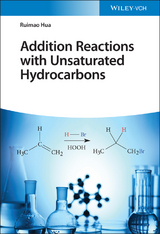Addition Reactions with Unsaturated Hydrocarbons
Wiley-VCH (Verlag)
978-3-527-34189-4 (ISBN)
Dr. Ruimao Hua is the professor of chemistry at the Department of Chemistry, Tsinghua University (TU) in Beijing, China. Having obtained his Ph.D degree from Tokyo Institute of Technology, he spent six years working at AIST in Japan before taking up his present appointment at TU. Professor Hua has over 100 published scientific papers and more than 50 authorized patents contributing to organic synthetic methodologies and liquid crystals. He is also the member of editorial board of several academic journals including Current Organic Synthesis, Mini-Reviews in Organic Chemistry, Reports in Organic Chemistry, Journal of Chemistry and Applications.
Chapter 1. Dimerization of Alkynes and Alkenes
1.1 Markovnikov Dimerization of Terminal Alkynes
1.2 anti-Markovnikov (head-to-head) Dimerization of Terminal Alkynes
1.3 Dimerization and Cross-dimerization of Terminal Alkenes
1.4 Cross-Dimerization of Different Alkynes or Alkynes with Alkenes
Chapter 2. Addition of C(sp)-H Bonds to Unsaturated Compounds
2.1 Addition of Terminal Alkynes to Carbonyl Compounds
2.2 Addition of Terminal Alkynes to Alkenes
2.3 Addition of Terminal Alkynes to Imines
2.4 Addition of Terminal Alkynes to Other Compounds
Chapter 3. Functionalized Alkenes from Hydrofunctionalization of Alkynes
3.1 Hydroborations of Alkynes
3.2 Hydrosilylation of Alkynes
3.3 Hydrostannation of Alkynes
3.4 Hydroamination of Alkynes
3.4.1 Hydroamination of alkynes with primary amines
3.4.2 Hydroamination of alkynes with secondary amines
3.4.3 Cyclohydroamination of alkynes
3.4.4 Aminocarbonylation of alkynes
3.5 Hydrophosphination of Alkynes and Related H-P(O) Addition
3.5.1 Hydrophosphination of Alkynes
3.5.2 Addition of PV(O)-H bond to alkynes
3.6 Hydrothiolation of Alkynes
3.6.1 Markovnikov hydrothiolation of alkynes
3.6.2 anti-Markovnikov hydrothiolation of alkynes
3.7 Addition of O-Nucleophiles to Alkynes
3.7.1 Addition of alcohols and phenols to alkynes
3.7.2 Addition of acids to alkynes
Chapter 4. Hydrofunctionalization of Carbon-Carbon Double Bonds
4.1 Hydroboration of Alkenes
4.1.1 Markovnikov hydroboration of alkenes
4.1.2 anti-Markovnikov hydroboration of alkenes
4.1.3 Hydroboration of allenes and 1,3-dienes
4.1.4 Asymmetric hydroboration of alkenes
4.2 Hydrosilylation of Carbon-Carbon Double Bonds
4.2.1 Markovnikov and anti-Markovnikov hydrosilylation of alkenes
4.2.2 Hydrosilylation of allenes
4.2.3 Hydrosilylation of 1,3-dienes
4.2.4 Asymmetric hydrosilylation of alkenes
4.3 Hydrostannation of Carbon-Carbon Double Bonds
4.4 Hydroamination of Carbon-Carbon Double Bonds
4.4.1 Markovnikov hydroamination of alkenes
4.4.2 anti-Markovnikov hydroamination of alkenes
4.4.3 Hydroamination of allenes and 1,3-dienes
4.4.4 Asymmetric hydroamination of alkenes
4.4.5 Nitrogen-heterocycles from intramolecular hydroamination of alkenes
4.5 Hydrophosphination of Alkenes and Related PV(O)-H Addition
4.6 Hydrothiolation of Carbon-Carbon Double Bonds
4.7 Addition of O-Nucleophiles to Alkenes
Chapter 5. Double Functionalization of Alkynes and Alkenes by Addition of Element-Element Bonds
5.1 Addition Reaction of Group 13 Element-Element Bonds
5.1.1 cis-Addition reactions to alkynes
5.1.2 trans-Addition reactions to alkynes
5.1.3 Addition reactions to alkenes
5.1.4 Synthesis of 1,1-diborylalkanes/alkenes via addition of B-B bond
5.2 Addition Reaction of Group 14 Element-Element Bonds
5.3 Addition Reaction of Group 15 Element-Element Bond
5.4 Addition Reactions of Group 16 Element-Element Bond
5.4.1 cis-Addition reactions to alkynes
5.4.2 trans-Addition reactions to alkynes
5.4.3 Different heteroatom bond addition reactions to alkynes
5.4.4 Addition reactions to alkenes
5.5 Addition Reactions of Element-Element Bonds from Different Group Heteroatoms
5.5.1 cis-Addition reactions to alkynes
5.5.2 trans-Addition reactions to alkynes
5.5.3 Addition reactions to alkenes
Chapter 6. Double Functionalization of Alkynes by Addition of Carbon-Element Bonds
6.1 Addition Reactions of Carbon-Group 13 Bonds
6.2 Addition Reactions of Carbon-Group 14 Bonds
6.2.1 Addition reactions of carbon-silicon bonds
6.2.2 Addition reactions of carbon-germanium bonds
6.2.3 Addition reactions of carbon-tin bonds
6.3 Addition Reactions of Carbon-Group 15 Bonds
6.4 Addition Reactions of Carbon-Group 16 Bonds
6.4.1 Addition reactions of carbon-oxygen bonds
6.4.2 Addition reaction of carbon-sulfur bonds
6.4.3 Addition reactions of carbon-selenium bonds
6.5Addition Reactions of Carbon-Halogen Bonds to Alkynes
6.5.1 C(sp3)-X activation and its addition reactions
6.5.2 C(sp2)-X activation and its addition reactions
6.5.3 C(sp)-X activation and its addition reactions
6.6 Addition Reactions of Carbon-Carbon Single Bonds
6.6.1 Addition reactions of strained C-C bonds
6.6.2 Addition reactions of C-CN bonds
6.6.3 Other carbon-carbon bond cleavage and their addition reactions
Chapter 7. Carbocycles from Annulation of Alkynes and Alkenes
7.1 Four-Membered Carbocycles
7.1.1 Construction of cyclobutenes
7.1.2 Construction of cyclobutanes
7.2 Five-Membered Carbocycles
7.2.1 Five-membered carbocycles by [2+2+1] cycloaddition
7.2.2 Five-membered carbocycles by [3+2] cycloaddition
7.2.3 Intramolecular cycloaddition of active sp3 C-H to carbon-carbon unsaturated bonds
7.2.4 Five-membered carbocycles from intramolecular cycloaddition of unsaturated bond
7.3 Six-Membered Carbocycles
7.3.1 Benzene ring formation
7.3.2 Naphthalene and polyaromatic hydrocarbon (PAHs) ring formation
7.3.3 1,3-Cyclohexadiene ring formation via cycloaddition of alkynes
7.4 Seven-Membered Carbocycles
7.5 Eight and Higher-Membered Carbocycles
Chapter 8. Heterocycles from Cycloaddition of Alkynes
8.1 Four-Membered Heterocycles
8.2 Five-Membered Heterocycles
8.2.1 Pyrroles, furans and thiophenes synthesis
8.2.2 Indoles, benzo[b]furans, benzo[b]thiophenes and benzo[b]selenophenes
8.2.3 Five-membered rings with two heteroatoms
8.3 Six-Membered Heterocycles
8.3.1 Pyridine derivatives via cycloaddition of alkynes with nitriles
8.3.2 Benzopyridine derivatives (quinolines and isoquinolines)
8.3.3 2-Pyridone derivatives and their benzo-derivatives (quinolinones and isoquinolonones)
8.3.4 Six-membered N-heterocycles having two nitrogen atoms
8.3.5 2-Pyrone, coumarin, isocoumarin and chromone derivatives
8.4 Other Heterocycles
Chapter 9. Carbonyl Compounds from Alkynes and Alkenes
9.1 Hydration of Alkynes
9.2 Hydroformylation of Alkynes and Alkenes
9.3 Hydroacylation of Alkynes and Alkenes
9.4 Hydroamidation of Alkynes and Alkenes
9.5 Hydrocarboxylation of Alkynes and Alkenes
9.6 Hydroesterification of Alkynes and Alkenes
9.7 Carbonylation of Alkynes and Alkenes
Chapter 10. Natural Product Synthesis via Alkyne Transformation
10.1 Hydrofunctionalization of Alkynes in Natural Product Synthesis
10.2 Double Functionalization of Alkynes in Natural Product Synthesis
10.3 Cycloaddition of Alkynes in Natural Product Synthesis
10.4 Carbonylation of Alkynes in Natural Product Synthesis
| Erscheinungsdatum | 30.06.2020 |
|---|---|
| Verlagsort | Weinheim |
| Sprache | englisch |
| Maße | 170 x 244 mm |
| Gewicht | 1004 g |
| Themenwelt | Naturwissenschaften ► Chemie ► Organische Chemie |
| Naturwissenschaften ► Chemie ► Technische Chemie | |
| Technik | |
| Schlagworte | Biochemie • Biochemie u. Chemische Biologie • Biochemistry (Chemical Biology) • Chemie • Chemistry • Kohlenwasserstoffe • Organic Chemistry • Organische Chemie • Pharmaceutical & Medicinal Chemistry • Pharmazeutische u. Medizinische Chemie |
| ISBN-10 | 3-527-34189-7 / 3527341897 |
| ISBN-13 | 978-3-527-34189-4 / 9783527341894 |
| Zustand | Neuware |
| Informationen gemäß Produktsicherheitsverordnung (GPSR) | |
| Haben Sie eine Frage zum Produkt? |
aus dem Bereich




